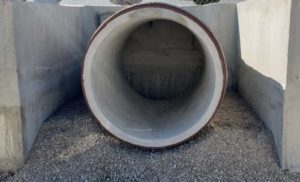
This rigid versus flexible pipe installation display visually demonstrates the differences in required trench widths and embedment*. Each pipe is 36” diameter, but trench widths and structural embedment requirements differ. Before specifying your next project, take a look at some of the installation requirements.
Prestressed Concrete Cylinder Pipe/AWWA C301 (Rigid)
- The majority of the strength required to resist external load comes from the pipe itself; embedment does not contribute significantly.
- Select material is normally required only for haunch areas.
- Trench widths require limited compaction and are generally narrower than flexible pipe. Cost savings can be realized compared to semi-rigid and flexible pipe from using native material taken from the trench to embed a rigid pipe.
Bar Wrapped/AWWA C303 (Semi-Rigid)
- The strength required to resist external loads comes from both the pipe and the embedment.
- Select material is usually only required for the embedment of the lower half of the pipe diameter.
- Semi-rigid pipe trench widths require limited compaction and are normally narrower than those for flexible pipe.
- Cost savings can be realized compared to flexible pipe from using native material taken from the trench to embed the upper half of semi-rigid pipe.
Steel/AWWA S200 and Fiberglass FRP/AWWA C950 (Both Flexible)
- For both options embedment provides the majority of strength required to resist external loads. The pipe contributes very little strength to the pipe/embedment structure.
- In most cases select material is required for the embedment. The trench is filled above the top of the pipe.
- Trench widths are normally wider than rigid and semi-rigid pipe due to the required compaction efforts.
Due to the required select material and full pipe embedment, flexible pipe installation costs are generally greater compared to rigid and semi-rigid pipe.
*Embedment is the backfill material in the pipe zone.
